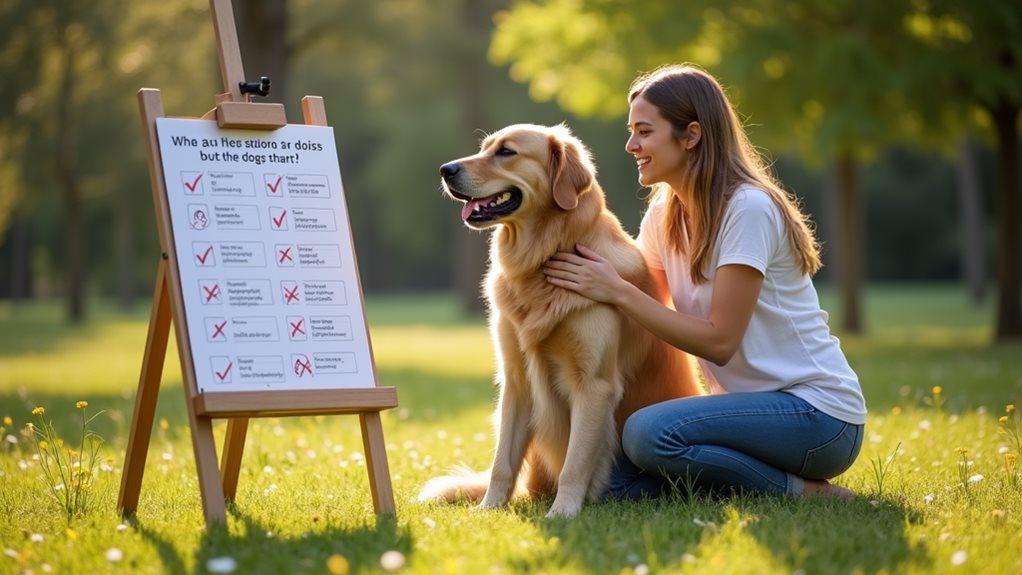
Overcoming a fear of dogs involves understanding traumatic triggers and learning about canine behaviors and signals. Therapies like exposure therapy, cognitive restructuring, and relaxation techniques such as hypnosis can aid in reducing fear. Knowledge of dogs' body language helps predict their behavior, promoting safer interactions. Combining these strategies enhances effectiveness, fostering a gradual return to confidence in the presence of dogs. Further exploration of these methods offers the potential for a deeper transformation in one's response to dogs.
Key Takeaways
- Engage in exposure therapy to gradually reduce fear by controlled interactions with calm and friendly dogs.
- Learn to interpret dog body language to understand their emotions and intentions better.
- Practice relaxation techniques such as guided hypnosis or breathing exercises to manage anxiety around dogs.
- Consider cognitive training to reshape negative perceptions and thoughts about dogs.
- Join support groups to share experiences and learn coping strategies from others with similar fears.
Understanding the Nature of Dog Phobias
Understanding the nature of dog phobias is essential for both individuals suffering from this fear and those who support them. The fear origins often trace back to negative or traumatic experiences with dogs, such as being bitten or witnessing an attack.
Such dog trauma can imprint deeply, creating an enduring fear. Recognizing these triggers is important in addressing and managing the phobia effectively. By acknowledging the impact of these traumatic events, individuals can begin the journey toward overcoming their fear.
Empathy and scientific understanding play significant roles in this process, helping to reconstruct a sense of safety and trust around dogs.
Canine Behavior and Body Language Basics
Canine behavior and body language provide essential insights into a dog's emotional state and intentions. Observing canine communication cues is pivotal for understanding these animals.
Tail wagging, for instance, can signify happiness or nervousness, depending on the motion's speed and breadth. A relaxed posture with a gently wagging tail generally indicates friendliness, whereas a stiff body might signal discomfort or aggression.
Recognizing dog body signals such as ear positioning, eye contact, and facial expressions helps predict their next move, ensuring safer interactions. This knowledge not only reduces fear but also enhances mutual respect between humans and dogs, fostering a positive coexistence.
Therapeutic Techniques for Managing Fear

Building on the knowledge of canine behavior and body language, individuals with a fear of dogs can further benefit from a variety of therapeutic techniques specifically designed to manage and reduce fear. Techniques like exposure therapy are essential, gradually increasing contact with dogs under controlled conditions to foster familiarity and emotional resilience. This method not only helps in reducing fear but also in building confidence and coping skills in the presence of dogs.
| Technique | Purpose | Outcome |
|---|---|---|
| Exposure Therapy | Gradual desensitization to dogs | Reduced fear, increased comfort |
| Cognitive Training | Reshape negative thoughts about dogs | Enhanced emotional resilience |
| Behavioral Adjustments | Practice safe interactions with dogs | Improved confidence around dogs |
| Simulation Exercises | Virtual reality or pictorial exposure | Prepares for real-life encounters |
| Support Groups | Share experiences and strategies | Emotional support, community learning |
Hypnosis and Relaxation Strategies
Hypnosis and relaxation strategies offer powerful tools for those grappling with a fear of dogs. These methods are designed to ease the mind into a state conducive to overcoming deep-seated anxieties.
Here are key components:
- Guided Hypnosis: Utilizes structured hypnosis techniques to foster deep relaxation and reprogram fearful reactions.
- Breathing Exercises: Fundamental relaxation methods to reduce immediate anxiety and stress.
- Progressive Muscle Relaxation: Gradually relaxes each muscle group, enhancing overall calmness.
- Visualization: Encourages imagining positive interactions with dogs, changing the emotional response.
Empirically, these strategies have shown promise in reducing phobic responses and enhancing emotional resilience.
The Role of NLP in Transforming Perceptions

Neuro-Linguistic Programming (NLP) offers transformative potential for those struggling with a fear of dogs, utilizing advanced psychological strategies to alter perceptions and responses. Techniques like NLP anchoring and the Swish pattern are pivotal in this transformation. Anchoring helps individuals connect positive emotional states to the presence of dogs, changing their emotional landscape. The Swish pattern enables rapid shifts from negative to positive visual and mental representations of dogs. These methods are scientifically structured to foster a new, positive relationship with dogs.
| Technique | Description |
|---|---|
| NLP Anchoring | Associates positive emotions with the presence of dogs. |
| Swish Pattern | Replaces negative dog-related thoughts with positive ones. |
Combining Therapies for Enhanced Results
While individual therapies such as hypnosis, EFT, and NLP offer significant benefits in addressing dog phobia, combining these methods can amplify their effectiveness.
Integrative therapy harnesses the strengths of each approach to build a more resilient therapeutic framework, enhancing emotional resilience.
Key aspects of this combined strategy include:
- Synergistic Effect: Each therapy complements the others, providing a more thorough treatment.
- Enhanced Emotional Resilience: Integrative approaches foster deeper emotional healing and resilience against phobia triggers.
- Customized Treatment Plans: Tailored combinations address specific aspects of an individual's fear.
- Sustained Recovery: Multi-modal strategies support long-term management of fear and anxiety.
Tracking and Celebrating Your Progress

Tracking progress and celebrating milestones are essential components in the journey to overcoming a fear of dogs. Individuals are encouraged to engage in fear journaling, a methodical approach where experiences and feelings are documented.
This practice not only helps in identifying triggers and patterns but also in recognizing progress milestones. As these milestones are acknowledged, they act as powerful motivators, reinforcing the positive steps taken.
Celebrating these achievements, no matter how small, plays a significant role in building confidence and resilience. This systematic tracking and celebration help maintain momentum and provide a clear view of the progress made towards conquering the phobia.
Lifelong Strategies for Coping With Fear
Adopting lifelong strategies for coping with fear of dogs begins with embracing a holistic approach that integrates continuous learning and practice.
Key components include:
- Regular engagement in mindfulness practices to enhance emotional regulation and presence.
- Long-term support from professionals and peer groups to sustain motivation and provide guidance.
- Continuous education about canine behavior to demystify and reduce fear triggers.
- Implementation of gradual exposure techniques to build confidence and reduce anxiety.
These strategies collectively foster a resilient mindset, empowering individuals to manage and eventually overcome their fear, leading to improved interactions with dogs and enhanced personal well-being.
Frequently Asked Questions
How Can Children Overcome Their Fear of Dogs?
Children can overcome their fear of dogs through gradual exposure, introducing them to calm, friendly dogs in controlled settings. Positive reinforcement encourages progress, enhancing confidence and reducing anxiety during these interactions.
Are Certain Dog Breeds Easier for Phobic Individuals to Tolerate?
Certain dog breeds, particularly small breeds and designated therapy dogs, may be easier for phobic individuals to tolerate due to their size, temperament, and training to exhibit calm and comforting behaviors.
What Role Do Genetics Play in Fear of Dogs?
Genetic predisposition may influence an individual's fear of dogs, suggesting that inherited fears can shape responses to animals. Understanding genetic factors offers insights into phobias and potential avenues for tailored therapeutic interventions.
Can Watching Dog Videos Online Help Reduce Fear?
Viewing various videos of dogs online can potentially aid in reducing fear by serving as a form of virtual dog therapy, providing positive reinforcement and gradually desensitizing individuals to their canine-related anxieties.
Is Fear of Dogs Related to Other Animal Phobias?
Fear of dogs often correlates with other animal phobias, suggesting a broader anxiety mechanism. Phobia similarities include generalized fear responses and avoidance behaviors, highlighting a need for extensive therapeutic approaches to address these interconnected fears.
Conclusion
In an extraordinary leap toward personal liberation, individuals plagued by canine phobias have at their fingertips revolutionary therapies that promise not just coping mechanisms but a complete metamorphosis of fear. The amalgamation of hypnosis, NLP, and EFT—akin to wielding a psychological superpower—can transform dread into comfort and avoidance into affinity. Embrace these scientifically-backed strategies to initiate a journey not just of recovery but of profound and awe-inspiring transformation in your relationship with dogs.



